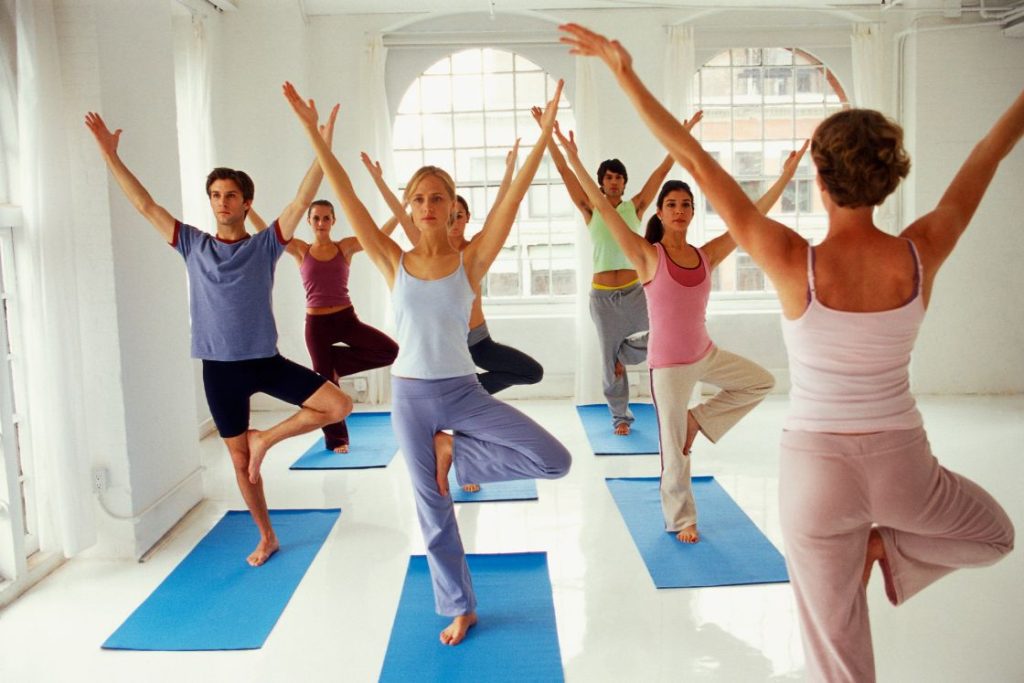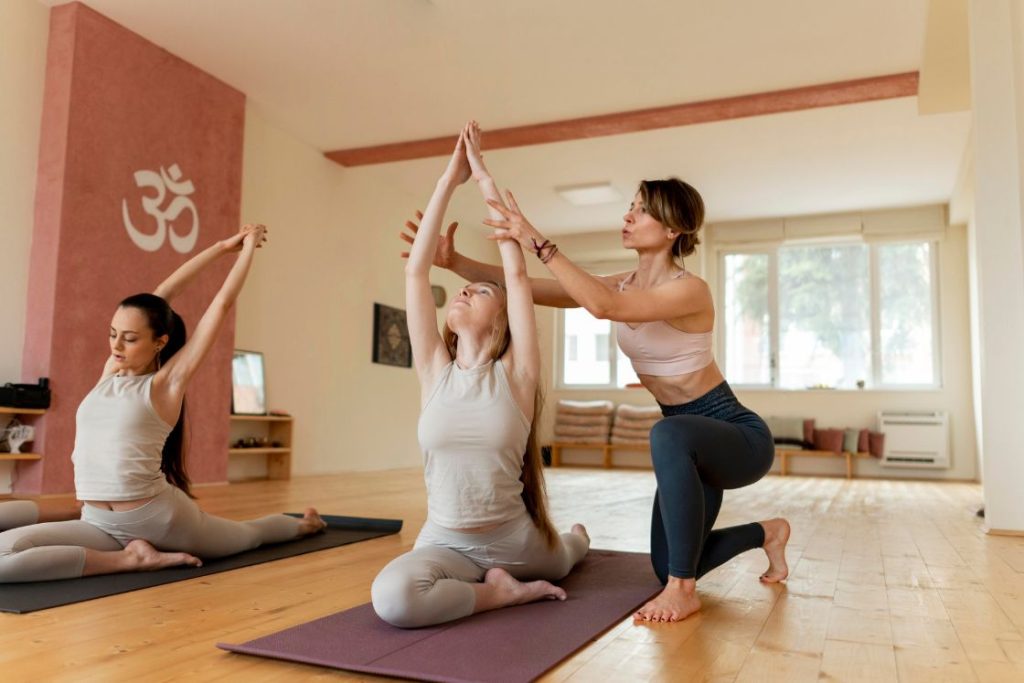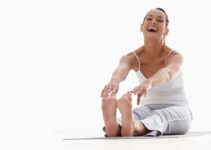
Designing a sequence for beginners yoga class may seem easy at first.
Beginner yoga students tend to concentrate heavily on their teacher’s instructions regarding the proper way to move, where to place their hands, and other details during a yoga class.
One thing to remember is that the majority of yoga sequences are linear, which means that each position is performed in succession. The teaching of linear classes follows a logical progression that begins with a mild breath engagement and gradual warming of the muscles and joints, moves through dynamic poses that finally wind down into long stretches, and returns to less difficult before savasana.
Whether you are a yoga teacher or you are someone who wants to start a home practice, structuring a sequence for yoga class requires a flow that will be beneficial for your muscles and joints. In this article, we have suggested a sequence/structure that is common for beginners along with some tips that you can keep in mind when designing your class.
You may also like: What to Expect and How to Prepare for First Yoga Class?
Structure of a typical Yoga class

While the structure of a yoga class can vary depending on the style of yoga and the teacher’s approach, here is a general outline of how a typical yoga class might unfold for beginners:
Centering and Breathing
A yoga class usually starts with a few moments of centering (preferably in a seated meditative pose), where the teacher invites the students to settle into the space and become present. This is often followed by a few minutes of conscious breathing exercises (pranayama) to help calm the mind and prepare the body for the practice.
Warm-Up
After centering, the teacher then guides the students through a series of gentle warm-up poses to help loosen up the muscles and joints. These poses can vary depending on the style of yoga, but might include things like gentle stretches, simple movements, and/or basic sun salutations.
Main Practice
This is where the bulk of the class happens, and it usually involves a sequence of more challenging poses (asanas) that are designed to build strength, flexibility, and balance.
The teacher will often provide detailed instructions on how to move in and out of each pose safely and with proper alignment. Depending on the style of yoga, the main practice might include a mix of standing, seated, and/or inverted poses.
- Standing or Balancing Poses – Start with beginner-standing and balancing poses such as Mountain Pose, Tree Pose, Chair Pose, and the Warrior Pose series. You are building up the energy in the body by practising a series of standing balancing poses.
- Peak Poses – Now that the body has gained some strength, it is time to practice some peak poses which may include a few inversions. Poses that target a specific area of the body can be included such as Bridge Pose, Wheel Pose, and Seated Spinal Twists.
- Seated or Supine Poses – You should now begin to wind down your practice with some seated or supine poses such as Bound Angle Pose, Boat Pose, Cobra Pose, Seated Forward Bend, and Thunderbolt Pose. These work as a way to wind down the yoga practice and give the body the required stretch to cool down.
Cool-down
After the main practice, the teacher will guide the students through a series of cooling and restorative poses designed to help the body and mind relax and rejuvenate. This might include things like gentle twists, forward folds, and/or supported poses using props like blankets and bolsters.
Final Relaxation
The class usually ends with a few minutes of final relaxation (savasana) where the students lie down on their backs and allow themselves to fully let go and rest. During this time, the teacher might offer some words of encouragement or guidance, or they might simply let the students rest in silence.
Closing the class
The class typically concludes with a few closing words from the teacher and perhaps a collective “Namaste” to acknowledge and honor the shared experience of the practice. You may end the class with a short meditation or simply chant a yoga mantra.
Overall, the structure of a yoga class is designed to be a holistic and balanced experience that integrates breath, movement, and mindfulness to help students cultivate greater awareness, strength, and inner peace.
Also read: 8 Important Things to Consider Before Joining a Yoga Class
Tips to design a yoga class for Beginners

Here are 6 tips that can help you build a sequence and teach a beginner yoga class:
Consider the group level you are teaching
Being a beginner does not imply that you are in bad form or are unfit. Those who are new to yoga are referred to as beginners. A yoga class for beginners may include students with a range of fitness levels, physical capabilities, limits, body kinds, and personal interests, as well as those who practice yoga for an array of reasons.
Plan your yoga class theme with the understanding that you may need to modify poses to meet the expectations and requirements of the students you are teaching.
Keep the transitions simple
When you initially teach poses to new students, make your transitions easy to foster confidence and prevent needless anxiety. You desire good learning experiences and increased student confidence. When introducing new positions to yoga beginners, you should make your transitions easy. If you’re losing your students in the middle of practice, there’s no reason for difficult movements done purely for aesthetic reasons.
Keep your instructional language as simple as possible
When you use terms like mula bandha, chakras, vayu mudra, or ujjayi, don’t presume that your students will understand what you mean. As an alternative, utilize language that non-yogis will comprehend or slowly add new words by explaining it.
The Sanskrit names of the yoga poses also fit into this category. Before teaching the Sanskrit name of the position, convey it a name in the language that your students understand.
Avoid giving too many cues and instructions
You don’t want to overload or confuse new students by providing them with too many cues and modifications. It can be unpleasant, frustrating, and confusing to be overloaded with information. It’s wise to keep with the pose’s fundamental shape when instructing beginners and to only help them enter the form of the pose.
Provide positive feedbacks
Try to be as unbiased as possible. Avoiding vocabulary like “right” and “wrong,” “flexible” and “tight,” or even “good alignment” and “bad alignment,” is necessary to achieve this. You ought to refrain from using critical language while making suggestions for changes or corrections.
Always strive to give your students a favorable first impression of yoga so that you can assist them to achieve their goals. Honouring each student’s unique abilities, for instance, by providing detailed positive feedback, is a simple way to do this.
Focus on highlighting your students’ talents rather than attempting to “fix” what’s wrong with them.
Spare some time for queries
It’s normal to have doubts when you just start studying a new skill. Inform the class that questions are encouraged if you don’t mind students interrupting you during instruction.
And if at all feasible, show up slightly sooner to address any pre-class questions. You should also be prepared to stay a few minutes past the end of the session should someone have a question they’d like to ask privately rather than in the public.
Conclusion
Designing and sequencing a yoga class for beginners requires an understanding of the unique needs and challenges of students, as well as the principles of effective sequencing and teaching.
By creating a safe and supportive environment, selecting appropriate poses and modifications, and incorporating breathing techniques and meditation, teachers can help beginners build a strong foundation for their yoga practice.
With consistent effort and guidance, students can cultivate greater awareness, strength, and inner peace, and experience the transformative power of yoga in their lives.




